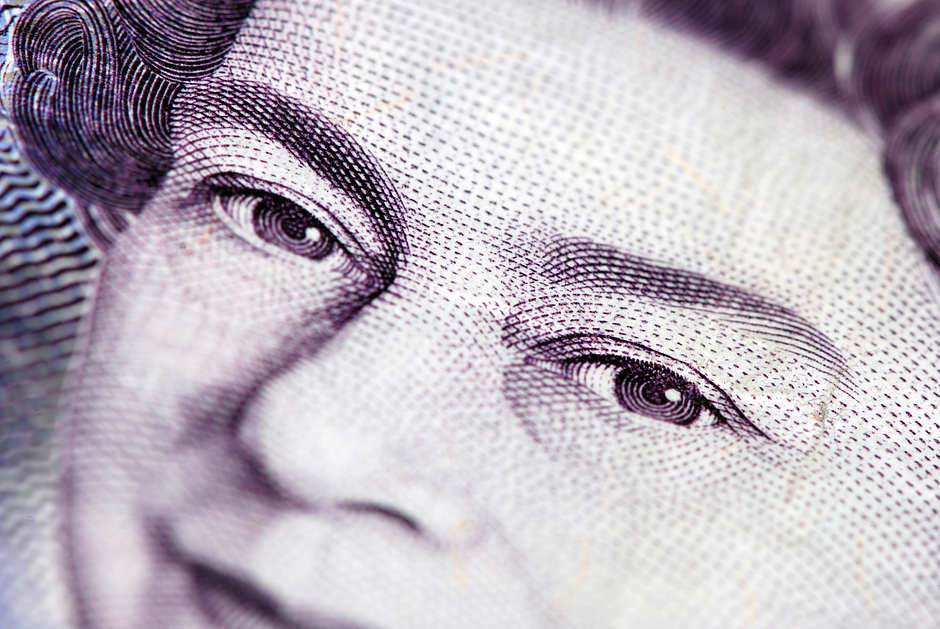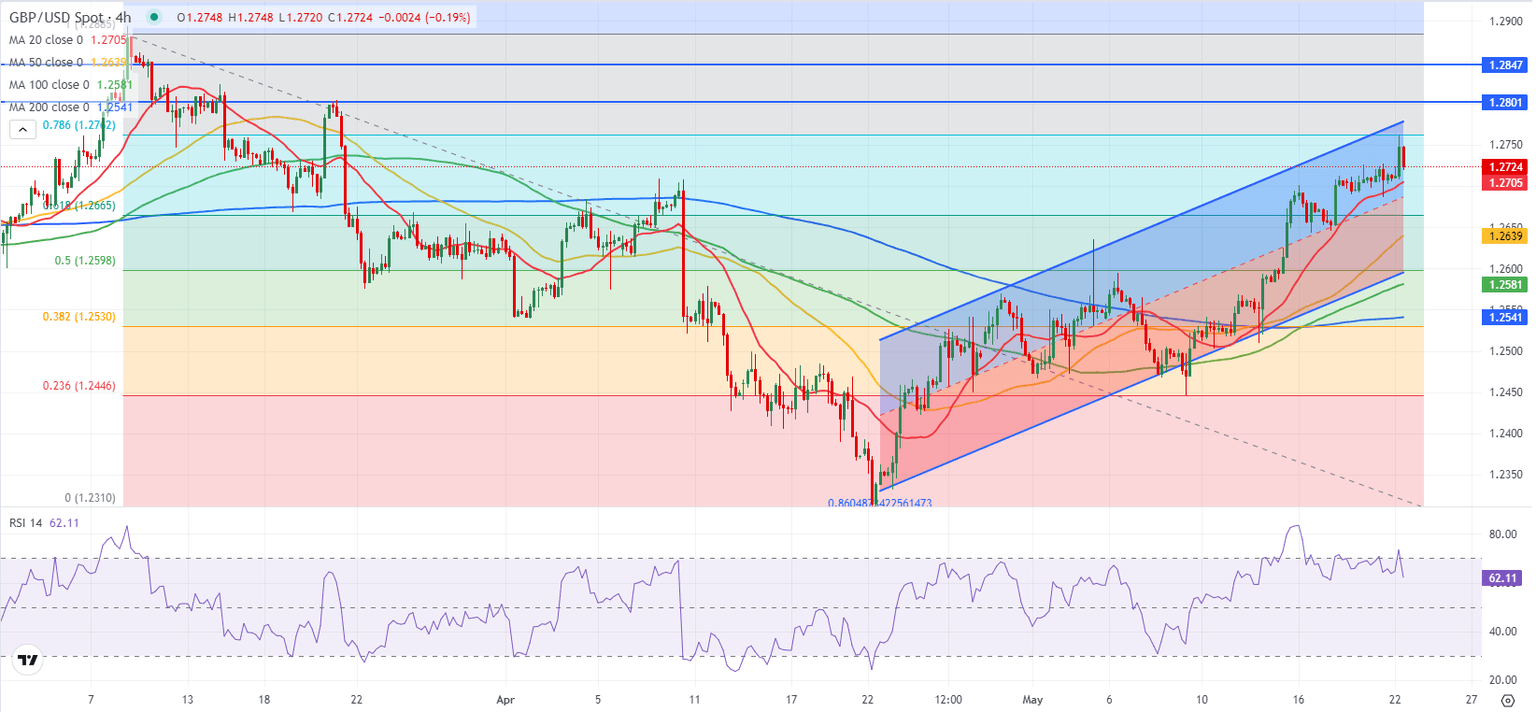GBP/USD Forecast: Pound Sterling edges higher as markets doubt BoE pivot in June
- GBP/USD climbed to a two-week high above 1.2750 on Wednesday.
- Inflation in the UK declined at a slower pace than expected in April.
- Markets doubt a BoE policy pivot in June.

GBP/USD gathered bullish momentum and reached its strongest level since March 21 above 1.2750 in the early European session on Wednesday. Although the pair erased a large portion of its gains, it holds comfortably above 1.2700.
The data published by the UK's Office for National Statistics (ONS) showed on Wednesday that inflation in the UK, as measured by the change in the Consumer Price Index (CPI), declined to 2.3% on a yearly basis in April from 3.2% in March. This reading, however, came in above the market expectation of 2.1%. The core CPI, which excludes volatile food and energy prices, rose 3.9% in the same period, surpassing analysts' estimate of 3.6%.
UK CPI inflation declines to 2.3% in April, closing in on BoE's target.
According to Reuters' BOEWATCH tool, the probability of a Bank of England (BoE) rate cut in June declined to 12% from 50% after the release of the inflation data. On the same not, Barclay's announced that they removed the expectation of a BoE policy pivot in June. Similarly, TD Securities analysts said that they are now anticipating the BoE to lower the policy rate in August, instead of June.
British Pound PRICE Today
The table below shows the percentage change of British Pound (GBP) against listed major currencies today. British Pound was the strongest against the Swiss Franc.
| USD | EUR | GBP | JPY | CAD | AUD | NZD | CHF | |
|---|---|---|---|---|---|---|---|---|
| USD | 0.08% | -0.12% | 0.20% | 0.08% | 0.10% | -0.34% | 0.25% | |
| EUR | -0.08% | -0.19% | 0.10% | 0.00% | 0.02% | -0.44% | 0.17% | |
| GBP | 0.12% | 0.19% | 0.30% | 0.17% | 0.22% | -0.25% | 0.37% | |
| JPY | -0.20% | -0.10% | -0.30% | -0.13% | -0.11% | -0.55% | 0.06% | |
| CAD | -0.08% | -0.01% | -0.17% | 0.13% | 0.02% | -0.40% | 0.16% | |
| AUD | -0.10% | -0.02% | -0.22% | 0.11% | -0.02% | -0.45% | 0.17% | |
| NZD | 0.34% | 0.44% | 0.25% | 0.55% | 0.40% | 0.45% | 0.60% | |
| CHF | -0.25% | -0.17% | -0.37% | -0.06% | -0.16% | -0.17% | -0.60% |
The heat map shows percentage changes of major currencies against each other. The base currency is picked from the left column, while the quote currency is picked from the top row. For example, if you pick the British Pound from the left column and move along the horizontal line to the US Dollar, the percentage change displayed in the box will represent GBP (base)/USD (quote).
Later in the American session, the Federal Reserve (Fed) will release the minutes of the April 30-May 1 policy meeting. Since this meeting took place before the US inflation data for April, the minutes are unlikely to offer any new information that could influence the market pricing of the Fed rate outlook.
GBP/USD Technical Analysis
GBP/USD faces strong resistance at 1.2760 -1.2775, where the Fibonacci 78.6% retracement of the latest downtrend meets the upper limit of the ascending regression channel. Above this resistance area, 1.2800 (psychological level, static level) could act as next interim resistance before 1.2850 (static level).
On the downside, 1.2705-1.2700 (20-period Simple Moving Average (SMA) on the 4-hour chart, mid-point of the ascending channel) aligns as key support before 1.2660 (Fibonacci 61.8% retracement) and 1.2640 (50-period SMA).
Inflation FAQs
Inflation measures the rise in the price of a representative basket of goods and services. Headline inflation is usually expressed as a percentage change on a month-on-month (MoM) and year-on-year (YoY) basis. Core inflation excludes more volatile elements such as food and fuel which can fluctuate because of geopolitical and seasonal factors. Core inflation is the figure economists focus on and is the level targeted by central banks, which are mandated to keep inflation at a manageable level, usually around 2%.
The Consumer Price Index (CPI) measures the change in prices of a basket of goods and services over a period of time. It is usually expressed as a percentage change on a month-on-month (MoM) and year-on-year (YoY) basis. Core CPI is the figure targeted by central banks as it excludes volatile food and fuel inputs. When Core CPI rises above 2% it usually results in higher interest rates and vice versa when it falls below 2%. Since higher interest rates are positive for a currency, higher inflation usually results in a stronger currency. The opposite is true when inflation falls.
Although it may seem counter-intuitive, high inflation in a country pushes up the value of its currency and vice versa for lower inflation. This is because the central bank will normally raise interest rates to combat the higher inflation, which attract more global capital inflows from investors looking for a lucrative place to park their money.
Formerly, Gold was the asset investors turned to in times of high inflation because it preserved its value, and whilst investors will often still buy Gold for its safe-haven properties in times of extreme market turmoil, this is not the case most of the time. This is because when inflation is high, central banks will put up interest rates to combat it. Higher interest rates are negative for Gold because they increase the opportunity-cost of holding Gold vis-a-vis an interest-bearing asset or placing the money in a cash deposit account. On the flipside, lower inflation tends to be positive for Gold as it brings interest rates down, making the bright metal a more viable investment alternative.
Premium
You have reached your limit of 3 free articles for this month.
Start your subscription and get access to all our original articles.
Author

Eren Sengezer
FXStreet
As an economist at heart, Eren Sengezer specializes in the assessment of the short-term and long-term impacts of macroeconomic data, central bank policies and political developments on financial assets.


















